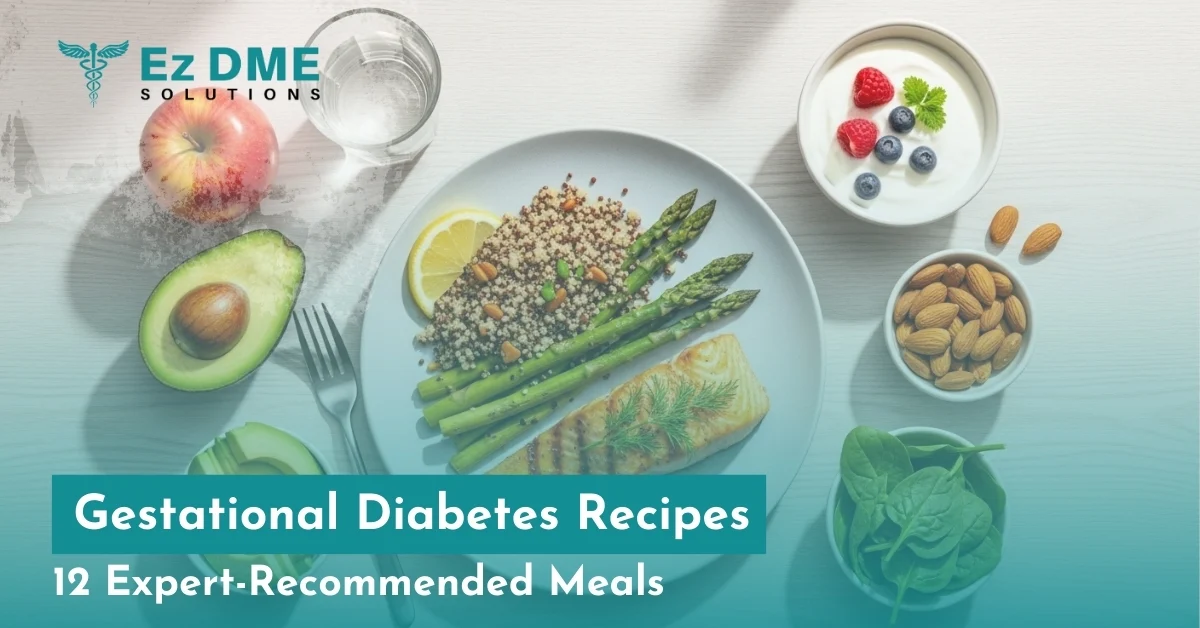No products in the cart.
Gestational Diabetes Recipes: 12 Expert-Recommended Meals
Understanding Gestational Diabetes and Nutrition Basics
Gestational diabetes mellitus (GDM) is the failure of insulin production to covert the demand of the body’s demand during pregnancy. Food plays a major role in managing GDM.
A proper diet should:
- Focus on low-glycemic, slow-digesting foods
- Be high in protein and fiber
- Include healthy fats
- Avoid refined sugars and ultra-processed carbs
This approach helps keep blood sugar steady and provides energy for both mother and baby.
Did you know continuous glucose monitors (CGMs), such as the Dexcom G7, can track your blood sugar 24/7 without finger pricks, while also providing glucose trends and high/low alerts?
Why Diet Matters in Gestational Diabetes
GDM stems from hormonal changes that affect insulin. Poor glucose control can cause:
- Large baby size (macrosomia)
- Preeclampsia
- Low newborn blood sugar
- Higher C-section rates
The first step is medical nutrition therapy in treatment. If diet fails to maintain the target blood sugar, insulin may be prescribed.
- Target blood glucose: Target blood glucose levels should be below 140 mg/dL one hour after meals. Aim for around 175 grams of carbohydrates per day, evenly distributed across meals and snacks.
Key Dietary Guidelines for Gestational Diabetes
Use this table to guide balanced meals:
| Nutrient | Per Meal Target | Purpose in GDM |
| Carbohydrates | 30–45 grams | Controls post-meal blood sugar |
| Protein | 15–30 grams | Supports fetal growth and hunger control |
| Fiber | At least 3 grams | Slows glucose absorption |
| Healthy fats | 10–15 grams | Improves satiety and helps with nutrient uptake |
| Sodium | Under 500 mg | Helps manage blood pressure during pregnancy |
Avoid:
- Refined grains
- Fruit juices
- Sweets or desserts
- Sugary beverages
Choose:
- Whole grains, lean protein, non-starchy vegetables, and beans.
Sample Daily Meal Plan for Gestational Diabetes
Designed to stabilize blood glucose and maintain nutrition:
Breakfast: Greek Yogurt with Chia Seeds
- Carbs: 30g
- Protein: 18g
- Fiber: 6g
Low-glycemic berries and chia seeds help with satiety and sugar control.
Snack 1 : Apple with Almond Butter
- Carbs: 15g
- Protein: 5g
- Fiber: 3g
Combines fruit with fat and protein for better glucose control.
Lunch: Grilled Chicken Bowl
- Carbs: 40g
- Protein: 28g
- Fiber: 7g
Includes whole grains and fiber-rich veggies for lasting energy.
Snack 2: Boiled Egg and Cucumber
- Carbs: 1g
- Protein: 6g
- Fiber: 1g
Taking Low-carb and high protein ideal for blood sugar stability.
Dinner: Brussels Sprouts with Baked Salmon
- Carbs: 20g
- Protein: 30g
- Fiber: 8g
Omega-3-fatty acid-rich salmon maintains brain function and blood glucose.
Snack 3: Cinnamon with Cottage Cheese
- Carbs: 6g
- Protein: 12g
- Fiber: 0g
Slow-digesting protein for stable overnight glucose.
Total Macros:
- Carbohydrates: 112g
- Fiber: 25g
- Protein: 99g
-112gram carbs, 25gram fiber, 99gram protein
Breakfast Food for Gestational Diabetes
1. Chia Yogurt with Berries
Ingredients:
- ¾ cup plain Greek yogurt
- 2 tbsp chia seeds
- ¼ cup blueberries
- ¼ cup strawberries
- Cinnamon (optional)
Instructions:
Mix yogurt with cinnamon with chia seeds. Top with berries. Let it sit for 10 minutes.
Nutrition:
Carbs: 30g
Protein: 18g
Fiber: 6g
Why it works:
Greek yogurt and chia slow down digestion, reducing sugar spikes.
2. Vegetable Omelette
Ingredients:
- 2 eggs
- ¼ cup spinach
- 2 tbsp tomatoes
- 1 tbsp onions
- 1 tsp olive oil
Instructions:
Sauté vegetables in oil. Add eggs. Cook until firm.
Nutrition:
- Carbs: 4g
- Protein: 14g
- Fiber: 2g
Lunch Recipes for Gestational Diabetes
3. Grilled Chicken and Quinoa Bowl
Ingredients:
- ½ cup cooked quinoa
- 1 cup grilled chicken
- ½ cup steamed broccoli
- ¼ avocado
- lemon juice, Olive oil
Instructions:
Combine ingredients. Add lemon and olive oil.
Nutrition:
- Carbs: 40g
- Protein: 28g
- Fiber: 7g
4. Spinach Soup and Lentil
Ingredients:
- Half a cup of cooked lentils
- Half a cup of low-sodium broth
- Half a cup of spinach
- Garlic, black pepper
Instructions:
Simmer lentils in broth. Add spinach at the end. Serve hot.
Nutrition:
- Carbs: 20 grams
- Protein: 30 grams
- Fiber: 8 grams
5. Brussels Sprouts with Baked Salmon
Ingredients:
- 4 oz salmon
- 1 cup Brussels sprouts
- 1 tsp olive oil
- Rosemary, lemon and pepper
Instructions:
For 20 minutes, roast salmon and sprouts.
Nutrition:
- Carbs: 20 grams
- Protein: 30 grams
- Fiber: 8 grams
6. Turkey Meatballs with Zucchini Noodles
Ingredients:
- Spiralized, 1 zucchini
- 3 oz lean turkey
- ¼ cup no-sugar tomato sauce
- Oregano, basil
Instructions:
Bake turkey into meatballs. Sauté zucchini. Mix with sauce and herbs.
Nutrition:
- Carbs: 14g
- Protein: 22g
- Fiber: 3g
Snack Ideas for Gestational Diabetes
Avoid snacks high in carbs without protein or fibre. Pick combinations that limit sugar spikes.

Smart Snacks:
- Hard-boiled egg + celery
- Cottage cheese + cucumber slices
- Small apple + 1 tbsp peanut butter
- Cheese stick + 5 whole grain crackers
All of these choices provide equal nutrition and fulfilment without affecting blood sugar.
Foods to Avoid in Gestational Diabetes
Limit foods that lead to fast sugar rises:
- White bread, pasta, or rice
- Sugary snacks and cereals
- Soda, fruit juices
- Packaged, processed foods
- Baked goods with added sugar
Use whole grains, fibre-rich snacks, and natural ingredients instead.
Meal Prep Tips for GDM
Planning ahead reduces stress and helps keep meals consistent.
- Batch-cook proteins like chicken, turkey, or lentils
- Pre-cut veggies for stir-fries and salads
- Freeze leftovers with labels
- Pack healthy snacks in your bag for emergencies
Consistency keeps blood sugar stable and reduces food-related stress.
Final Thoughts
Having gestational diabetes doesn’t mean giving up good food. You can enjoy tasty food that is healthy for your blood sugar and pregnancy requirements.
These gestational diabetes recipes are constructed with professional advice to provide you with confidence with each meal. Whether you’re looking for gestational diabetes dinner recipes or quick snacks, this article provides useful advice.
Always refer to your registered dietitian or OB-GYN to modify these recipes to meet your pregnancy requirements and blood glucose levels.





Leave a Reply